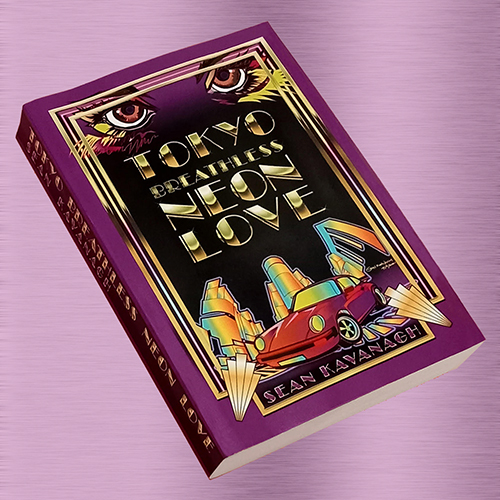How Micheal 'Davo' Davidson Paved the Way for The Future of Sydney Street Skating
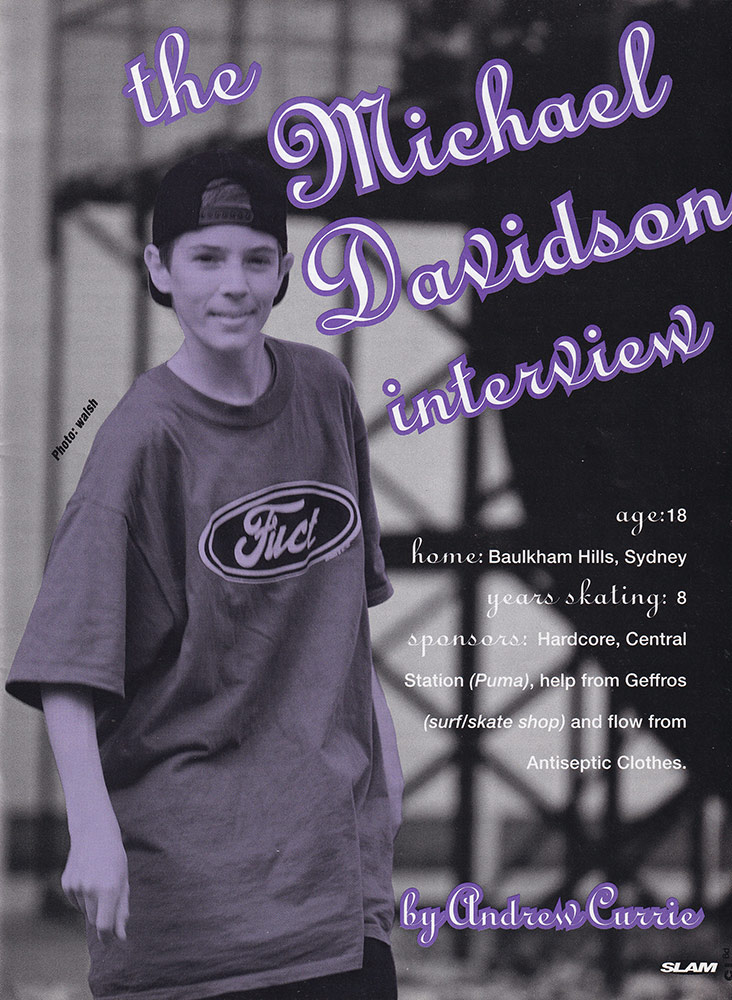
For this article I wanted to write about a pioneer of Street Skating in Australia, a person who I think was one of the true originators of Sydney's Street Skating scene - Michael 'Davo' Davidson.
90s Street Star
For a large part of the 90s, you could find photos of Michael Davidson in pretty much every Australian skateboarding magazine. Around the time I first met him, if I picked up a magazine, I knew I would probably see a photo, sequence or article about him. He even used to write monthly features in one of Australia's most famous Skateboarding magazines.
He was one of the skaters pioneering the future of what street skating would become in Australia. Street Style at this time was evolving from Vision Street Wear, Punk and 80s style monster style graphics into to the foundation of what is still seen today.
Technical Style Combined with Power
I really liked his skating because he had the ability to do the latest, most technical tricks and go really big combined. He had no fear facing huge sets of stairs and unconquered gaps. Like myself at the time, he was quite a small person, but his style on a board was definitely bold.
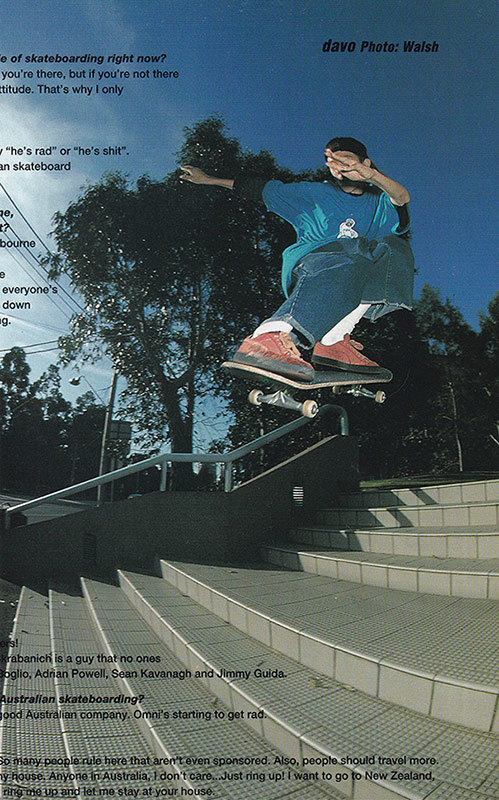
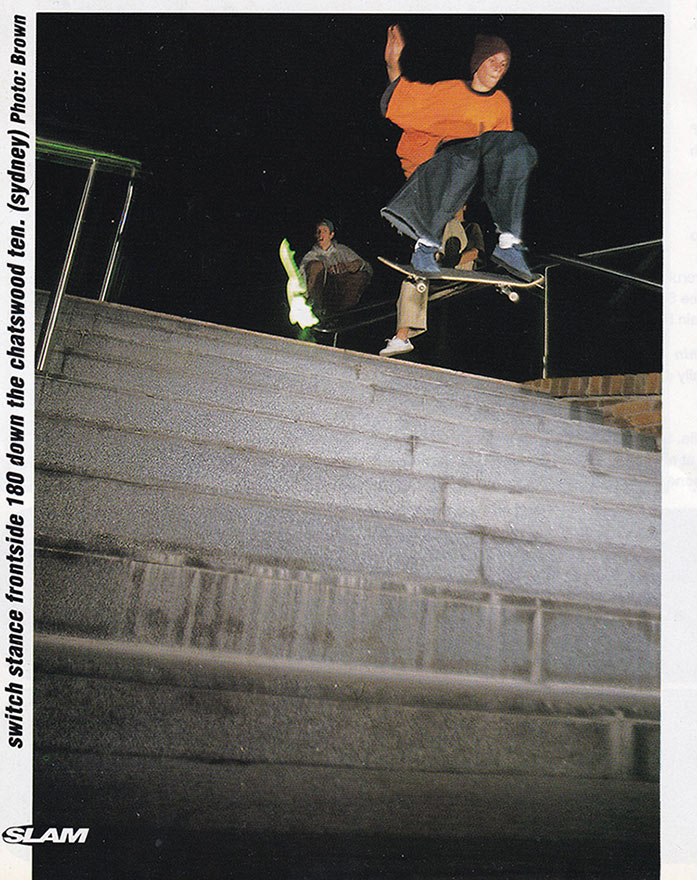
この記事では、オーストラリアとシドニーのストリートスケートシーンの先駆者であるマイケル「デイボ」 デイビッドソンについて書きたいと思います。 90年代には、オーストラリアのほとんどすべてのスケートボード雑誌でマイケル・デイビッドソンの写真を見つけることができました。 マイケルに初めて会った頃、スケート雑誌を手に取れば、必ず彼に関する写真と記事が目に入るだろうと思っていました。 彼はオーストラリアで最も有名なスケート雑誌の一つに毎月の特集記事を書いていました。
マイケルは、オーストラリアにおけるストリートスケートの未来を先駆けたスケーターの一人でした。 この当時のストリートスケートスタイルは、「VISION STREET WEAR」、パンクと80年代のモンスタースタイルのグラフィックから今日の基礎へと進化し始めていました。 マイケルは、最新の最もテクニカルなトリックだけでなく、大きなパワーのトリックもこなす能力を持っていました。 彼は巨大な階段から飛び越えることを恐れなかったです。当時の私と同じよに、マイケルはかなり小柄な人物でしたが、スケートボード上での彼のスタイルは間違いなくパワフルでした。
私がマイケルに初めて会ったのは、シドニーのタウンホール近くのジョージ・ストリートでした。 彼はスーパースピードで話し始め、サブカルチャーにたいする強い興味とシドニーのお気に入りの店について話してくれました。私たちはすぐに友達になりました。 マイケルがお気に入りの漫画とアニメの店について私に連れて行きたいと話していたのを覚えています。そこでは、 日本から勅諭輸入したオリジナルのペイントされたアニメセル画が販売されていました。
「マンガとは何ですか?」と思いました。
Meeting Davo for the First Time
The first time I met Michael was on George Street near Town Hall in Sydney. He knew my name was 'Sean' and as soon as we met, he started talking a hundred miles an hour telling me about all his intense interests in subculture and favorite shops in Sydney. We were instantly friends.
I distinctly remember him telling me about his favorite Manga and Animation shop that he wanted to take me to, which had original painted animation cells direct from Japan.
“What is Manga?” I thought to myself.
I did know what Japanese Comics and Animation were, but wasn't very familiar with it and couldn't understand why he was so excited to explain Manga to me. I loved American Pop Culture and actually didn't know very much about Japan at all. I bought an aqua blue animation cell of the face of Japanese Anime Character from Japan at the shop he took me to, not knowing that I would be in Japan in the near future.
An Amazing Talent for Japanese Language
At a very early age Michael could already speak Japanese fluently and told me that his ability had confused his teachers at school. Later on, he was pretty much at a native level.
I remember if anyone asked him how he spoke Japanese so well, he would just reply,
"Dokugaku."
'Dokugaku' means 'Self-Study' or learning by oneself.
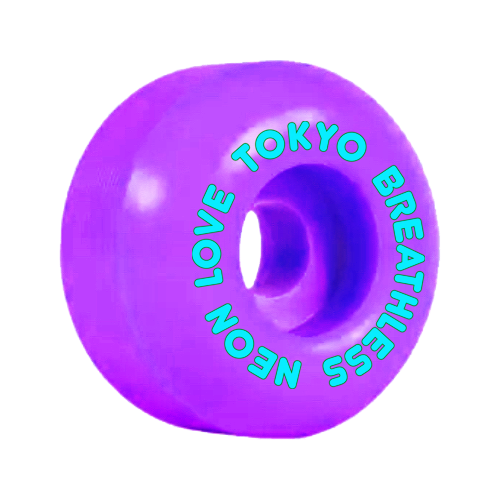
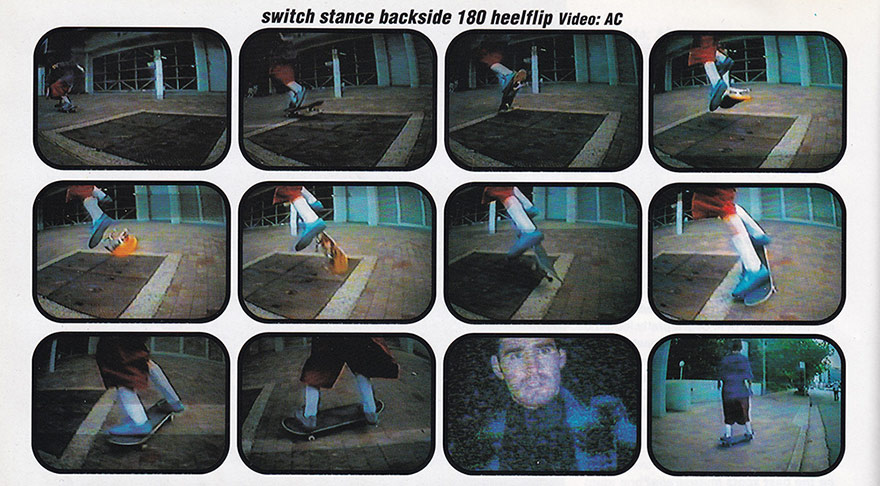
日本の漫画はすでにトップレベルとして世界中で有名でしたが、私は日本のことを全く知らなかったので、 なぜ彼がそんなに興奮して説明してくれたのか理解できませんでした。近い将来日本に来るとは知らずに、店で水色のアニメセル画を買いました。 マイケルは幼い頃からすでに日本語を話すことができ、その能力が学校の先生たちを困惑させた。 数年後、彼は日本語をネイティブのように話せました。 誰かがかれにどうしてそんなに上手に日本語を話せるのかと尋ねたら、彼はただこう答えたのを覚えています。
「独学」。
独学だけではなかったと思います。マイケルは幼い頃から日本と日本語について学ぶ天性の才能を持っていました。 多くのスケーターは知りませんでしたが、マイケルは知識欲を持つ非常に知的な人物です。私がマイケルと話すたびに、彼は本で学んだ興味深い知識と好きな作家について話してくれました。 マイケルは若い頃から、ヒップホップスタイルとテクニカルなストリートスタイルを組み合わせた、 オーストラリアで最も有名なストリートスケーターの一人として有名になりました。 バギーなXLデニムと2000年代のB-BOYスタイルの仮面の裏には、非常に知的で創造的な精神が隠されていました。 90年代以降、シドニー出身の多くのスケーターが国際的に有名になりました。 マイケル・デイビッドソンは、シドニーのスケートボーダーがマイケルはシドニーのスケーターが今日世界に到達することを可能にした基礎の一部を築いた真のパイオニアだったと思います。
私がこれらの物語を書いているのは、懐かしい時代と出会ったスケーターたちを振り返るのが楽しいからです。 当時、私たちはスケートボーダーとして家族のようなもので、これらのセッションは永遠に続くだろうと思っていました。 現実的には、一緒にスケートをした人のほとんどにはもう会えないと思います。私は幸運にも世界の色んな場所に旅行することができましたが、もう近くには住んでいません。
しかし、これらの物語を書くことで、言葉と思い出を通して、私は出会ったスケーターたち、 幸運にも出会うことができた多くのクリエーティブな人たちに感謝の気持ちを表すことができます。もう一度一緒にスケートをするようなものです。
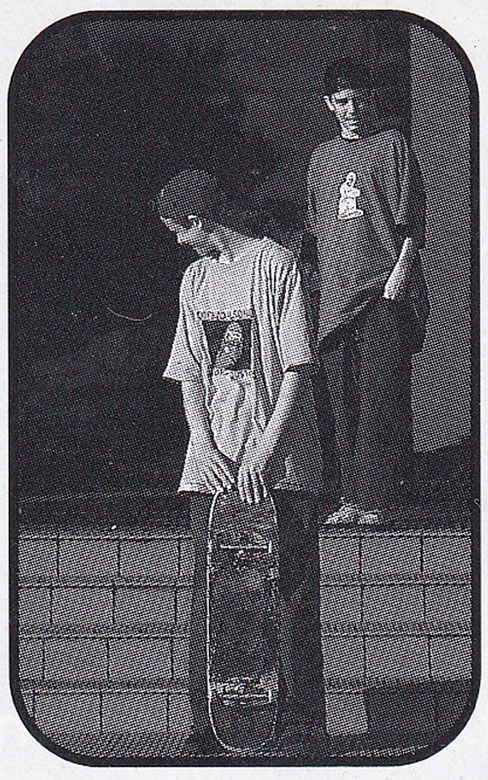
Michael 'Davo' Davidson with Ryan Denereaz - 1993
Photo by David Walsh
A Thirst for Knowledge
Although, I think it is more than that. Michael had a natural inclination and talent for learning about Japan and Language from a very early age. Which brings me to something many skateboarders who watched him, may not know. Michael is an extremely intelligent person who has a huge thirst for knowledge. Every time I spoke to him, he told me about interesting knowledge he had learnt in books, his favorite writers and literature.
From a young age he had become famous as one of Australia's most well-known Street Skaters, who was blending Hip Hop style into a bold, technical street style. Although behind the mask of 90s Polo Sport, baggy denim and 2000s b-boy style, lay an extremely intelligent and creative mind.
How Davo Paved the Way for The Future of Sydney Street Skating
Since the 90s many skateboarders from Sydney have gone on to international fame on a level anyone can see all around the world. At a time when Street Skating was really beginning and about to take the world by storm - I think Micheal Davidson was one of the true originators who laid part of the foundations that have allowed Sydney Skateboarders to reach the world today.
Sydney's Street Scene just wouldn't have been the same without him.
I write these stories because it is fun for me looking back to nostalgic times, the skate sessions I had and the people I met. At that time, I thought those sessions would go on forever, as skateboarders we were like family. Realistically, I probably won't get to see most of the people I skated with again. I am fortunate to have seen different parts of the world, but don't live that nearby anymore.
Although, by writing these stories - through words and memories I am able to session with the skaters I met once again and show appreciation for many of the creative people I was lucky to meet.
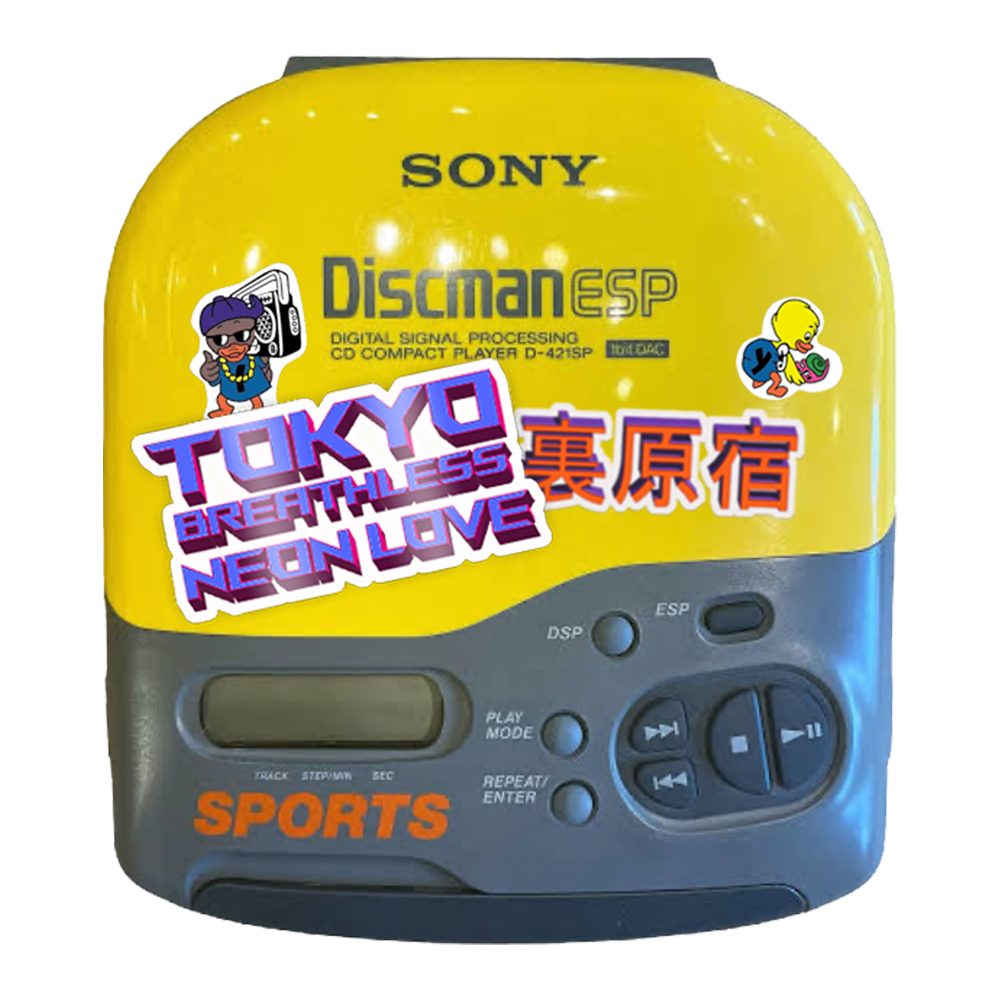
From the mid-90s to early 2000s portable CD players were an essential item that many skaters would carry in their backpacks while out skating the streets. Usually accompanied with a few hip hop CDs, it was a way to feel and experience the streets with a personal sound system. The trend was part function - part fashion.
90年代半ばから2000年代初頭にかけて、ポータブルCDプレーヤーはファッションアイテムであり、 多くのスケーターがバックパックに入れてストリートスケートをしていました。
By Sean Kavanagh 「ショーン・カバナ」
PS. Recently on the internet I see quite a lot of articles about the history of Skateboarding written by people who have never skated. What I think the writers of the articles don't realize is - It is very difficult to pull off.
Skateboarders are smart and very perceptive. It can very quickly be realized that the person who is acting like an authority on the subject has never actually put their feet on a board.
I think from reading the articles and stories on this site, it is pretty obvious I was actually there in the 90s and got to see the history of skateboarding unfolding before my eyes.
My book 'TOKYO BREATHLESS NEON LOVE' is even more, in fact… Way more intense and is an account if what life was like in Ura Harajuku right at that time. It actually gets you to experience what Harajuku was like, as if you were there.
Recently, Ura Harajuku has been becoming much more popular and there are many people doing commentary on scans of magazines from the time.
Although, unlike the keen perception of a skateboarder reading an article by a person and instantly knowing the writer has never skated, many young people can't tell. Both the writer and the reader may have been born around the time Ura Harajuku was at its peak - so people believe they are an authority on the subject.
So, to the authorities on the subject out there, I have a message...
You Cannot Compete With
TOKYO BREATHLESS NEON LOVE
Anybody who thinks they can, just hasn't read it… Or perhaps hopes nobody will notice that it exists. They just hope you won't find it.
I am here to tell you, and I mean it when I say it... That status of 'Unknown Book' is quickly changing.
The thing most people in the West don't know is, the magazine editors, writers and even many famous Tokyo photographers of the most classic Tokyo Fashion Magazines were not even a part of the Ura Harajuku scene. There were exceptions, although usually, they were allowed into showrooms for press and product features only (as some amount of advertising was needed) and very firmly asked to leave at speed. It was a very closed and intimidating world even for people living in Japan. It was way beyond the modern concept of 'gatekeeping'.
There was no point of entry for a normal person.
At the peak intensity of the Ura Hara Boom, there were only about three foreigners working daily in the very small scene (maybe one or two more). I think I was the first non-Japanese person there full time. Apart from a strict and almost impossible vetting process, it did actually take quite a lot of Japanese Language Proficiency to be able to be a part of what was going on.
Even the owners and head designers of Ura Harajuku's most famous and iconic Street Fashion Brands did not know the entirety of what was really going on in Ura Harajuku... There was a lot nobody ever knew.
TOKYO BREATHLESS NEON LOVE is a mystery within a mystery. For those that are able to read between the lines - will be able to see into another world.
As well as, get to experience all the crazy fun Harajuku and Tokyo was at the time as if you were right there!
